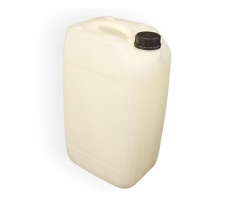Chloroform
| Infobox on Chloroform | |
|---|---|
| Example of Chloroform |  |
| Facts | |
| Origin | - |
| Stowage factor (in m3/t) | 1,27 m3/t (drums) |
| Humidity / moisture | - |
| Ventilation | - |
| Risk factors | See text |
Chloroform
Description
Chloroform is an organic compound with formula CHCl3. It is one of the four chloromethanes. The colorless, sweet-smelling, dense liquid is a trihalomethane, and is considered somewhat hazardous. Several million tons are produced annually as a precursor to Teflon and refrigerants, but its use for refrigerants is being phased out.
At normal temperature and pressures, chloroform is a highly volatile, clear, colourless, heavy, highly refractive, non-flammable liquid.
Unlike ether, chloroform's characteristically sweet odour isn't irritating, although inhalation of concentrated chloroform vapour may cause irritation of exposed mucous surfaces. Chloroform is a more effective anaesthetic than nitrous oxide. The metabolism of chloroform in the body is dose-dependent; it may be proportionally higher at lower levels of exposure. A substantial but variable percentage of chloroform from inspired air is retained in the body; it is extensively metabolized by the liver. Metabolites of chloroform include phosgene, carbene and chlorine, all of which may contribute to its cytotoxic activity. Prolonged administration of chloroform as an anaesthetic can cause toxaemia. Acute poisoning is associated with headache, altered consciousness, convulsions, respiratory paralysis and disturbances of the autonomic nervous system: dizziness, nausea, and vomiting are common. Chloroform may also cause delayed-onset damage to the liver, heart and kidneys. When used in anaesthesia, insensibility was usually preceded by a stage of excitation. This was followed by loss of reflexes, diminished sensation and loss of unitary consciousness.
Please note that Chloroform is also widely known as Trichloromethane.
Application
Fluorcarbon plastics, solvent, analytical chemistry, fumigant, insecticides.
There are many uses for Chloroform. It was originally used as an anaesthetic, but this is no longer very common – at least not in the developed world – as high doses are regarded as dangerous because the substance is chlorinated. Nowadays, Chloroform is mostly used in laboratories for analysis and testing purposes. It is also used in chromatography, pharmaceuticals and in the dental industry.
Shipment / Storage
Chloroform is classified as both Irritant and Harmful and should be treated in a suitable manner by qualified persons. Chloroform (CHCl3) has a specific odour which some individuals may find quite pleasant. Chloroform should only be handled in areas with good air circulation, ideally with fume extraction. It has a specific gravity of just under 1.5 (depending on temperature), meaning it is roughly 1.5 times the weight of water.
Keep from light. Miscible with alcohol, ether, benzene, carbon disulphide, carbon tetrachloride, fixed and volatile oils, slightly soluble in water.
Risk factors
Toxic by inhalation; anesthetic, pro-longed inhalation or ingestion may be fatal. TLV: 10 ppm in air, 50 mg/m3 of air. OSHA PEL: 50 ppm for 10 minutes. A carcinogen. It has been prohibited by FDA from use in drugs, cosmetics and food packaging, including cough medicines, toothpastes, etc. Nonflammable. Will burn on prolonged exposure to flame or high temperature.
See IMDG Code and applicable MSDS sheet.











